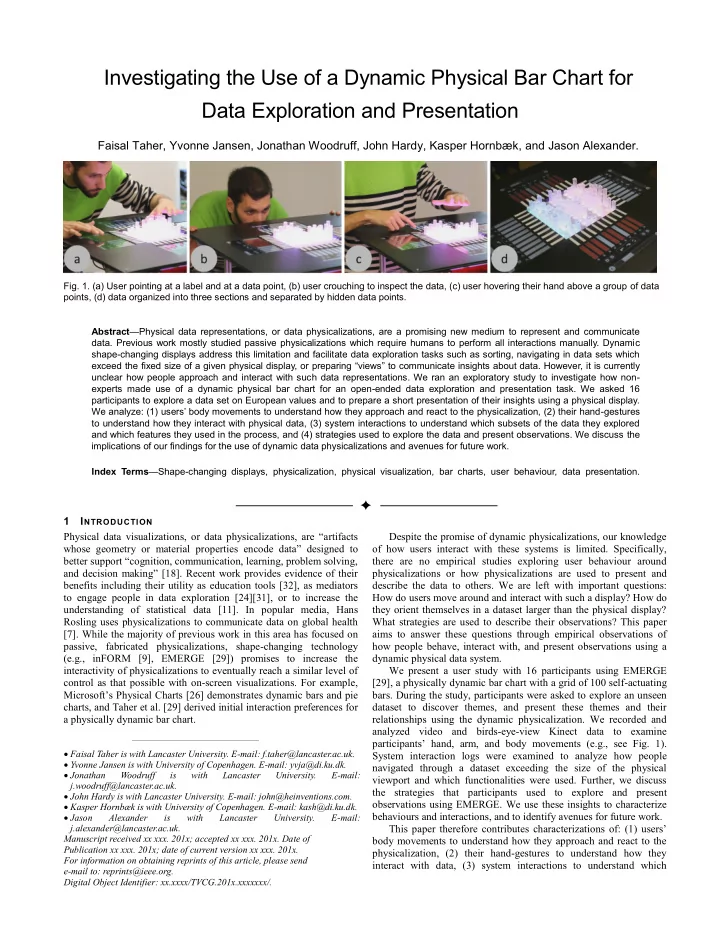

Investigating the Use of a Dynamic Physical Bar Chart for Data Exploration and Presentation Faisal Taher, Yvonne Jansen, Jonathan Woodruff, John Hardy, Kasper Hornbæk, and Jason Alexander. Fig. 1. (a) User pointing at a label and at a data point, (b) user crouching to inspect the data, (c) user hovering their hand above a group of data points, (d) data organized into three sections and separated by hidden data points. Abstract — Physical data representations, or data physicalizations, are a promising new medium to represent and communicate data. Previous work mostly studied passive physicalizations which require humans to perform all interactions manually. Dynamic shape-changing displays address this limitation and facilitate data exploration tasks such as sorting, navigating in data sets which exceed the fixed size of a given physical display, or preparing “ views ” to communicate insights about data. However, it is currently unclear how people approach and interact with such data representations. We ran an exploratory study to investigate how non- experts made use of a dynamic physical bar chart for an open-ended data exploration and presentation task. We asked 16 participants to explore a data set on European values and to prepare a short presentation of their insights using a physical display. We analyze: (1) users ’ body movements to understand how they approach and react to the physicalization, (2) their hand-gestures to understand how they interact with physical data, (3) system interactions to understand which subsets of the data they explored and which features they used in the process, and (4) strategies used to explore the data and present observations. We discuss the implications of our findings for the use of dynamic data physicalizations and avenues for future work. Index Terms — Shape-changing displays, physicalization, physical visualization, bar charts, user behaviour, data presentation. 1 I NTRODUCTION Physical data visualizations, or data physicalizations, are “a rtifacts Despite the promise of dynamic physicalizations, our knowledge whose geometry or material properties encode data” designed to of how users interact with these systems is limited. Specifically, better support “ cognition, communication, learning, problem solving, there are no empirical studies exploring user behaviour around and decision making ” [18]. Recent work provides evidence of their physicalizations or how physicalizations are used to present and benefits including their utility as education tools [32], as mediators describe the data to others. We are left with important questions: to engage people in data exploration [24][31], or to increase the How do users move around and interact with such a display? How do understanding of statistical data [11]. In popular media, Hans they orient themselves in a dataset larger than the physical display? Rosling uses physicalizations to communicate data on global health What strategies are used to describe their observations? This paper [7]. While the majority of previous work in this area has focused on aims to answer these questions through empirical observations of passive, fabricated physicalizations, shape-changing technology how people behave, interact with, and present observations using a (e.g., inFORM [9], EMERGE [29]) promises to increase the dynamic physical data system. interactivity of physicalizations to eventually reach a similar level of We present a user study with 16 participants using EMERGE control as that possible with on-screen visualizations. For example, [29], a physically dynamic bar chart with a grid of 100 self-actuating Microsoft’s Physical Charts [26] demonstrates dynamic bars and pie bars. During the study, participants were asked to explore an unseen charts, and Taher et al. [29] derived initial interaction preferences for dataset to discover themes, and present these themes and their a physically dynamic bar chart. relationships using the dynamic physicalization. We recorded and analyzed video and birds-eye-view Kinect data to examine participants’ hand, arm, and body movements (e.g., see Fig. 1). Faisal Taher is with Lancaster University. E-mail: f.taher@lancaster.ac.uk. System interaction logs were examined to analyze how people Yvonne Jansen is with University of Copenhagen. E-mail: yvja@di.ku.dk. navigated through a dataset exceeding the size of the physical Jonathan Woodruff is with Lancaster University. E-mail: viewport and which functionalities were used. Further, we discuss j.woodruff@lancaster.ac.uk. the strategies that participants used to explore and present John Hardy is with Lancaster University. E-mail: john@heinventions.com. observations using EMERGE. We use these insights to characterize Kasper Hornbæk is with University of Copenhagen. E-mail: kash@di.ku.dk. behaviours and interactions, and to identify avenues for future work. Jason Alexander is with Lancaster University. E-mail: j.alexander@lancaster.ac.uk. This paper therefore contributes characterizations of: (1) users ’ Manuscript received xx xxx. 201x; accepted xx xxx. 201x. Date of body movements to understand how they approach and react to the Publication xx xxx. 201x; date of current version xx xxx. 201x. physicalization, (2) their hand-gestures to understand how they For information on obtaining reprints of this article, please send interact with data, (3) system interactions to understand which e-mail to: reprints@ieee.org. Digital Object Identifier: xx.xxxx/TVCG.201x.xxxxxxx/.
Recommend
More recommend